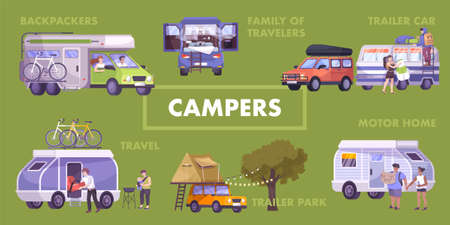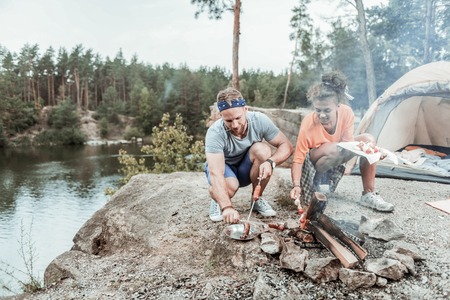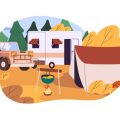Why Go Custom? The Freedom of Personalized Adventure Maps
Building your own adventure maps is all about taking control of your journey. When you create a custom map, you get to choose what matters most—whether it’s your favorite hiking trails, secret campsites, or those hidden streams perfect for a midday break. Unlike standard maps, which can feel generic and overwhelming, personalized maps let you focus on the details that inspire you. This freedom means you’re not just following someone else’s route—you’re shaping your own unique adventure. It’s about blending your personal interests with practical needs, making every trip more meaningful and connected to the landscapes you love. For campers in the U.S., where nature is vast and diverse, custom mapping tools offer a simple yet powerful way to plan journeys that truly reflect who you are and how you want to explore.
Essential Tools: Digital and Analog Mapping Options
For campers in the U.S., crafting a custom adventure map is as much about the tools as the journey itself. Whether you prefer digital convenience or analog charm, there’s a method that fits your style. Here’s a breakdown of user-friendly apps, websites, and paper-based approaches for DIY map-making, perfectly suited for American campers.
Top Digital Mapping Tools
| Tool | Platform | Best For |
|---|---|---|
| Gaia GPS | iOS, Android, Web | Backcountry navigation, offline maps |
| AllTrails | iOS, Android, Web | Trail discovery, route planning |
| Caltopo | Web, Mobile App | Custom topographic maps, layering data |
| Google My Maps | Web | Sharing custom routes with friends or groups |
| Avenza Maps | iOS, Android | Parks and public lands with georeferenced PDF maps |
User-Friendly Websites for Map Creation
- USGS National Map: Download free detailed topo maps of any region in the U.S.
- OpenStreetMap: Edit and customize open-source maps with camping points of interest.
- Mapbox Studio: Design personalized interactive maps for road trips or off-grid excursions.
- Bureau of Land Management (BLM) Maps: Access land status and recreation maps for public lands across America.
Packing Analog: Paper-Based Methods That Endure
If technology fails or you crave the tactile feel of pen and paper, traditional mapping methods remain timeless. Pick up a regional atlas from Rand McNally or Benchmark Maps—favorites among American campers for decades. Print out trail sections from digital sources like AllTrails or USGS and annotate them with your own notes. For creative souls, sketching your own route on blank graph or tracing paper lets you record campsites, landmarks, and detours in your unique style.
The Hybrid Approach: Best of Both Worlds
The most prepared campers blend both digital and analog tools. Start by plotting your route digitally for accuracy and easy updates. Then print out key sections or hand-copy waypoints to a field notebook. This ensures you’ll always have navigation options—whether your phone has signal or not.

3. Getting Started: Gathering Local Insights and Land Data
Building your own adventure map starts with finding reliable information tailored to the unique landscape of America’s great outdoors. For campers, sourcing accurate trail details, public land boundaries, and community-driven tips can turn a simple trip into an unforgettable experience. Start by tapping into trusted sources like the U.S. Forest Service, Bureau of Land Management (BLM), and National Park Service websites—these platforms provide official maps, trail updates, and access rules for millions of acres of public lands.
Trail Details from Local Sources
Beyond government databases, dive into crowd-sourced apps such as AllTrails or Gaia GPS, where fellow adventurers share up-to-date trail conditions and hidden gems. Many regional hiking clubs and state park sites also post downloadable maps and seasonal alerts that reflect real-time changes in the landscape. These local insights often reveal lesser-known routes, scenic overlooks, and safety advisories relevant to your chosen destination.
Understanding Public Lands Access
Navigating American public lands can be complex—boundaries between federal, state, and private property aren’t always obvious on commercial maps. Use interactive mapping tools like OnX or the BLM’s GeoCommunicator to overlay land ownership data onto your custom map. This ensures you stay within legal camping zones and respect protected habitats while exploring responsibly.
Tapping Into Community Wisdom
No one knows a place like those who frequent it. Join online forums such as Reddit’s r/CampingandHiking or Facebook groups dedicated to specific states or national parks. Here, seasoned locals offer advice on everything from water sources to wildlife activity—knowledge that elevates your trip planning beyond what any standard guidebook can provide. By combining official data with grassroots wisdom, you’ll craft a truly personalized adventure map that celebrates both the wild terrain and the community spirit of America’s outdoors.
4. Design Inspirations: Shapes, Scales, and Natural Landmarks
When creating your own adventure maps, blending natural beauty with useful information is key. The art lies in making maps that are visually calming yet rich in details campers need. Consider the following tips as you craft:
Keep Shapes Simple & Meaningful
Use gentle curves for rivers and trails, soft edges for forests, and simple icons for campsites or viewpoints. Avoid clutter; instead, let each element breathe so users can instantly recognize important features.
Choose the Right Scale
The scale determines how much detail you present. For local hikes, a larger scale (showing less area but more detail) helps highlight individual landmarks and campsite spots. For broader explorations, use a smaller scale to provide a holistic view while marking only essential stops.
| Map Type | Suggested Scale | Best For |
|---|---|---|
| Campsite Detail Map | 1:1,000 – 1:5,000 | Tent locations, water sources, fire pits |
| Trail Map | 1:10,000 – 1:25,000 | Main paths, elevation changes, rest areas |
| Regional Overview | 1:50,000+ | Larger terrain features, route planning |
Highlight Natural Landmarks Thoughtfully
Naturally occurring features like lakes, old-growth trees, or rock formations serve as both navigational aids and sources of inspiration. Use subtle earth-tone colors to draw attention without overwhelming the map. Small watercolor-style brush strokes or minimal icons can evoke a sense of place.
Balance Aesthetics with Utility
Always ensure that artistic touches don’t compromise readability. Legible fonts, clear contrast between trails and background terrain, and thoughtfully placed legends are essential. Test your design by asking others if they can easily identify key points without getting lost in decoration.
Tip:
If unsure about your map’s balance between style and function, print a black-and-white version—if it’s still easy to read, your map is ready for any adventure.
5. Sharing Maps with Friends and the Camping Community
Once you’ve crafted your own adventure map, sharing it can spark inspiration and help others explore the great outdoors. Custom maps become more valuable when they’re part of a community, supporting collective knowledge and new discoveries.
Saving Your Custom Maps
Most digital mapping tools let you save your creations in various formats, like PDFs or interactive web maps. Saving maps digitally ensures they’re ready to be updated or referenced for future trips, keeping your planning process efficient and organized.
Printing for Field Use
If you prefer paper on the trail, print your map before heading out. Use waterproof or tear-resistant paper to withstand outdoor conditions. Highlight key points like campsites, water sources, and emergency routes so your printed map is both practical and easy to read.
Digital Sharing Made Simple
To inspire others, consider uploading your maps to online platforms popular in the U.S., such as AllTrails or Gaia GPS. You can also share links via group chats or camping forums. Many mapping tools offer collaborative features, letting friends add notes or updates, turning your solo project into a group resource.
Building a Culture of Knowledge-Sharing
Sharing custom adventure maps helps grow a supportive camping community. By exchanging routes, tips, and hidden gems, everyone benefits from richer experiences and safer journeys. Your map could be the start of someone else’s unforgettable adventure—so don’t hesitate to pass it on.

